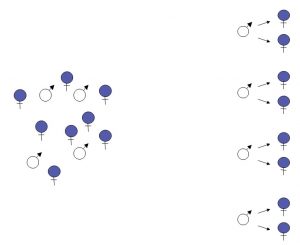We explore factors that throw sex ratios out of whack, and the implications of these “wack” sex ratios for population survival, mutation accumulation, and other important aspects of evolution. See Freedberg and Wade (2001, 2004), Freedberg (2002), Freedberg and Debenport (2014), and Butka and Freedberg (2019) for more on sex ratio evolution.
Sex Ratios
Because the ability to pass on one’s genes is dependent on finding a mate, the sex ratio (the relative proportion of males to females) is critical to population biology. When one sex outnumbers the other, as females do below, the rarer sex has a reproductive advantage. Because families with more sons will then have more descendents, alleles that cause parents to over-produce sons will increase in frequency over future generations, bringing the sex ratio back to 1:1.

